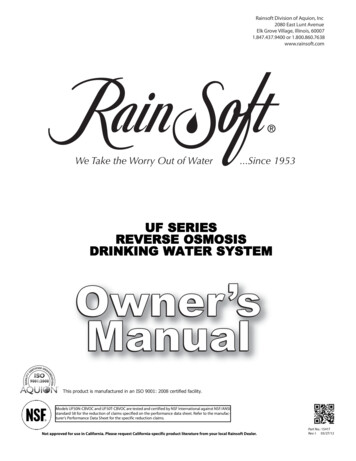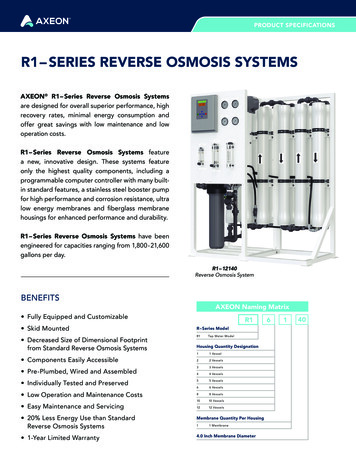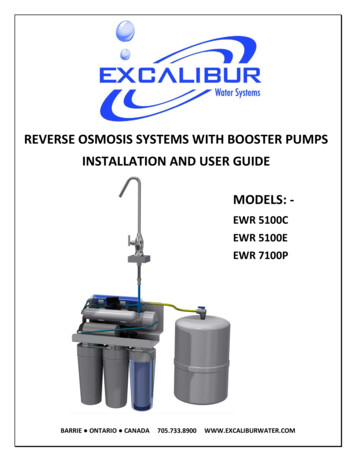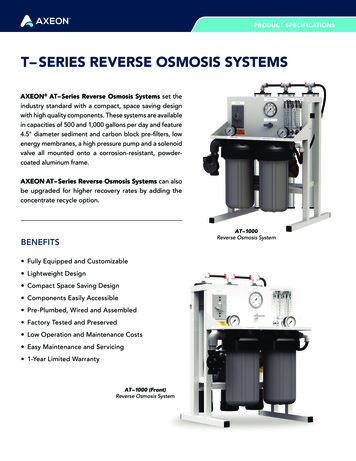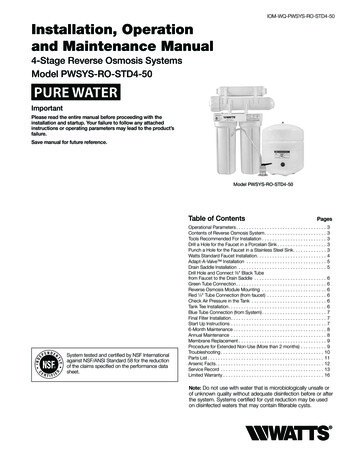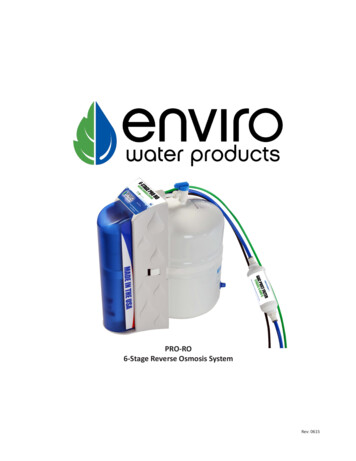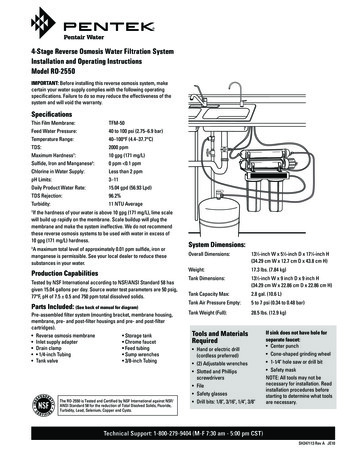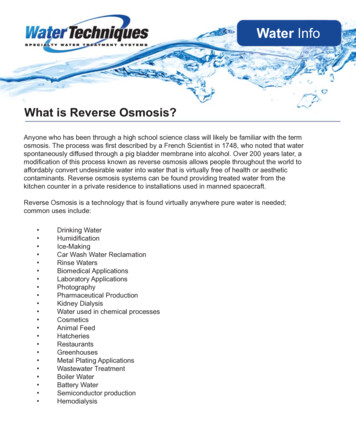
Transcription
Water InfoWhat is Reverse Osmosis?Anyone who has been through a high school science class will likely be familiar with the termosmosis. The process was first described by a French Scientist in 1748, who noted that waterspontaneously diffused through a pig bladder membrane into alcohol. Over 200 years later, amodification of this process known as reverse osmosis allows people throughout the world toaffordably convert undesirable water into water that is virtually free of health or aestheticcontaminants. Reverse osmosis systems can be found providing treated water from thekitchen counter in a private residence to installations used in manned spacecraft.Reverse Osmosis is a technology that is found virtually anywhere pure water is needed;common uses include: Drinking WaterHumidificationIce-MakingCar Wash Water ReclamationRinse WatersBiomedical ApplicationsLaboratory ApplicationsPhotographyPharmaceutical ProductionKidney DialysisWater used in chemical processesCosmeticsAnimal FeedHatcheriesRestaurantsGreenhousesMetal Plating ApplicationsWastewater TreatmentBoiler WaterBattery WaterSemiconductor productionHemodialysis
How Reverse Osmosis WorksA semi-permeable membrane, like the membrane of a cell wall or a bladder, is selectiveabout what it allows to pass through, and what it prevents from passing. These membranesin general pass water very easily because of its small molecular size; but also prevent manyother contaminants from passing by trapping them. Water will typically be present on bothsides of the membrane, with each side having a different concentration of dissolvedminerals. Since the water is the less concentrated solution seeks to dilute the moreconcentrated solution, water will pass through the membrane from the lower concentrationside to the greater concentration side. Eventually, osmotic pressure (seen in the diagrambelow as the pressure created by the difference in water levels) will counter the diffusionprocess exactly, and an equilibrium will form.The process of reverse osmosis forces water with a greater concentration of contaminants(the source water) into a tank containing water with an extremely low concentration ofcontaminants (the processed water). High water pressure on the source side is used to"reverse" the natural osmotic process, with the semi-permeable membrane still permittingthe passage of water while rejecting most of the other contaminants. The specific processthrough which this occurs is called ion exclusion, in which a concentration of ions at themembrane surface from a barrier that allows other water molecules to pass through whileexcluding other substances.
Semi-permeable membranes have come a long way from the natural pig bladders used inthe earlier osmosis experiments. Before the 1960's, these membranes were too inefficient,expensive, and unreliable for practical applications outside the laboratory. Modern advancesin synthetic materials have generally solved these problems, allowing membranes tobecome highly efficient at rejecting contaminants, and making them tough enough towithstand the greater pressures necessary for efficient operation.Even with these advances, the "reject" water on the source side of a Reverse Osmosis (RO)system must be periodically flushed in order to keep it from becoming so concentrated that itforms a scale on the membrane itself. RO systems also typically require a carbon pre-filterfor the reduction of chlorine, which can damage an RO membrane; and a sediment pre-filteris always required to ensure that fine suspended materials in the source water do notpermanently clog the membrane. Hardness reduction, either through the use of watersoftening for residential units or chemical softening for industrial use, may also be desirablein hard water areas.Low Pressure (Residential) SystemsLow pressure RO systems generally refer to those systems with a water feed pressure ofless than 100 psig. These are the typical countertop or under sink residential systems thatrely primarily on the natural water pressure to make the reverse osmosis process function; atypical system is shown schematically below.Typical Point of Use Reverse Osmosis System
Countertop units typically have an unpressurized storage tank; Under sink units typicallyhave a pressurized accumulator storage tank where the water pressure tends to increase asthe tank fills. This pressurized system provides sufficient pressure to move the water fromthe under sink storage tank to the faucet. Unfortunately, this also creates a back pressureagainst the membrane, which can decrease its efficiency. Some units overcome this byusing unpressurized tanks with a pump to get the treated water where it is needed.Low pressure units typically provide between 2 and 15 gallons per day of water, with anefficiency of 2-4 gallons of reject water per gallon of treated water. Water purity can be ashigh as 95 percent. These systems can be highly affordable, with countertop units starting atabout US 150, and under sink units starting at about US 500. These units produce waterfor a cost as low as ten cents per gallon once maintenance and water costs are factored in.Maintenance usually requires replacing any pre- or post-filters (typically one to four timesper year); and the reverse osmosis cartridge once every two to three years, depending onusage. Look for the WQA Gold Seal (S-300) to find products that have been successfullytested to industry performance standards; and to Certified Water Specialists (CWS I-VI),Certified Sales Representatives (CSR), and Certified Installers (CI) for advice on your waterneeds, and equipment installation.High Pressure (Commercial/Industrial) SystemsHigh pressure systems typically operate at pressures between 100 and 1000 psig,depending on the membranes chosen and the water being treated. These systems areusually used in industrial or commercial applications where large volumes of treated waterare required at a high level of purity.Most commercial and industrial systems use multiple membranes arranged in parallel toprovide the required quantity of water. The processed water from the first stage of treatmentcan then be passed through additional membrane modules to achieve greater levels oftreatment for the finished water. The reject water can also be directed into successivemembrane modules for greater efficiency (see diagram below), though flushing will still berequired when concentrations reach a level where fouling is likely to occur.
High pressure industrial units typically provide from 10 gallons to thousands of gallons perday of water with an efficiency of 1-9 gallons of reject water per gallon of treated water.Water purity can be as high as 95 percent. These systems tend to be larger and morecomplicated than low pressure systems, and this is reflected in their costs, which range fromUS 1000 through tens of thousands of dollars for a large, multi-module unit capable ofproviding desalinated drinking water for a resort facility or water bottling plant.What Reverse Osmosis TreatsReverse osmosis can treat for a wide variety of health and aesthetic contaminants.Effectively designed, RO equipment can treat for a wide variety of aesthetic contaminantsthat cause unpleasant taste, color, and odor problems like a salty or soda taste caused bychlorides or sulfates.RO can also be effective for treating health contaminants like arsenic, asbestos, atrazine(herbicides/pesticides). fluoride, lead, mercury, nitrate, and radium. When using appropriatecarbon prefiltering (commonly included with most RO systems), additional treatment canalso be provided for such "volatile" contaminants as benzene, trichloroethylene,trihalomethanes, and radon. Some RO equipment is also capable of treating for biologicalcontaminants like Cryptosporidium. The Water Quality Association (WQA) cautions,however, that while RO membranes typically remove virtually all known microorganisms andmost other health contaminants, design considerations may prevent a unit from offeringfoolproof protection when incorporated into a consumer drinking water system.When looking for a product to treat for a given health contaminant, care should be used tofind products that have been tested successfully for such purposes at a quality testinglaboratory.ConclusionReverse osmosis is a relatively new, but very effective, application of an establishedscientific process. Whether it is used to meet the needs of a typical family of four, or theneeds of an industrial operation requiring thousands of gallons per day, it can be a costeffective to provide the required quantity of highly treated water. With continual advances insystem and membrane design that boost efficiency and reliability, RO can be expected toplay a major role in water treatment for years to ----This article first appeared in the WaterReview Technical Brief, (1995) Volume 10, No. 3; apublication of the Water Quality Research Council; Copyright 1995 by the WQA. All rightsreserved.
Low Pressure (Residential) Systems Low pressure RO systems generally refer to those systems with a water feed pressure of less than 100 psig. These are the typical countertop or under sink residential systems that rely primarily on the natural water pressure to make the reverse osmosis process function; a typical system is shown schematically .

